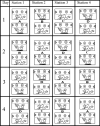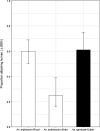Reduced human-biting preferences of the African malaria vectors Anopheles arabiensis and Anopheles gambiae in an urban context: controlled, competitive host-preference experiments in Tanzania
- PMID: 33218346
- PMCID: PMC7678205
- DOI: 10.1186/s12936-020-03495-z
Reduced human-biting preferences of the African malaria vectors Anopheles arabiensis and Anopheles gambiae in an urban context: controlled, competitive host-preference experiments in Tanzania
Abstract
Background: Host preference is a critical determinant of human exposure to vector-borne infections and the impact of vector control interventions. Widespread use of long-lasting insecticide-treated nets (LLINs) and indoor residual spraying (IRS) across sub-Saharan Africa, which protect humans against mosquitoes, may select for altered host preference traits of malaria vectors over the long term. Here, the host preferences of Anopheles arabiensis and Anopheles gambiae sensu stricto (s.s.) were experimentally assessed in the field, using direct host-preference assays in two distinct ecological settings in Tanzania.
Methods: Eight Ifakara Tent Trap (ITT), four baited with humans and four with bovine calves, were simultaneously used to catch malaria vectors in open field sites in urban and rural Tanzania. The numbers of mosquitoes collected in human-baited traps versus calf-baited traps were used to estimate human feeding preference for each site's vector species.
Results: The estimated proportion [95% confidence interval (CI)] of mosquitoes attacking humans rather than cattle was 0.60 [0.40, 0.77] for An. arabiensis in the rural setting and 0.61 [0.32, 0.85] for An. gambiae s.s. in the urban setting, indicating no preference for either host in both cases (P = 0.32 and 0.46, respectively) and no difference in preference between the two (Odds Ratio (OR) [95%] = 0.95 [0.30, 3.01], P = 0.924). However, only a quarter of An. arabiensis in the urban setting attacked humans (0.25 [0.09, 0.53]), indicating a preference for cattle that approached significance (P = 0.08). Indeed, urban An. arabiensis were less likely to attack humans rather than cattle when compared to the same species in the rural setting (OR [95%] = 0.21 [0.05, 0.91], P = 0.037).
Conclusion: Urban An. arabiensis had a stronger preference for cattle than the rural population and urban An. gambiae s.s. showed no clear preference for either humans or cattle. In the urban setting, both species exhibited stronger tendencies to attack cattle than previous studies of the same species in rural contexts. Cattle keeping may, therefore, particularly limit the impact of human-targeted vector control interventions in Dar es Salaam and perhaps in other African towns and cities.
Keywords: Anopheles; Entomological surveillance; Host preferences; Malaria; Residual transmission; Tanzania; Vector.
Conflict of interest statement
The authors declare that no competing interests.
Figures



Similar articles
-
Mosquito electrocuting traps for directly measuring biting rates and host-preferences of Anopheles arabiensis and Anopheles funestus outdoors.Malar J. 2019 Mar 18;18(1):83. doi: 10.1186/s12936-019-2726-x. Malar J. 2019. PMID: 30885205 Free PMC article.
-
Indoor and outdoor malaria vector surveillance in western Kenya: implications for better understanding of residual transmission.Malar J. 2017 Nov 6;16(1):443. doi: 10.1186/s12936-017-2098-z. Malar J. 2017. PMID: 29110670 Free PMC article.
-
Malaria vector species composition and entomological indices following indoor residual spraying in regions bordering Lake Victoria, Tanzania.Malar J. 2020 Oct 28;19(1):383. doi: 10.1186/s12936-020-03452-w. Malar J. 2020. PMID: 33115495 Free PMC article.
-
Plasticity of blood feeding behavior of Anopheles mosquitoes in Ethiopia: a systematic review.Parasit Vectors. 2024 Sep 28;17(1):408. doi: 10.1186/s13071-024-06493-1. Parasit Vectors. 2024. PMID: 39342300 Free PMC article.
-
Using the human blood index to investigate host biting plasticity: a systematic review and meta-regression of the three major African malaria vectors.Malar J. 2018 Dec 18;17(1):479. doi: 10.1186/s12936-018-2632-7. Malar J. 2018. PMID: 30563533 Free PMC article.
Cited by
-
Comparative evaluation of different versions of exposure-free mosquito electrocuting traps and barrier screen trap for monitoring outdoor densities and biting time phenotypes by malaria and filariasis vectors in Tanzania.Parasit Vectors. 2022 Nov 11;15(1):420. doi: 10.1186/s13071-022-05549-4. Parasit Vectors. 2022. PMID: 36369172 Free PMC article.
-
Seasonal variation in abundance and blood meal sources of primary and secondary malaria vectors within Kilombero Valley, Southern Tanzania.Parasit Vectors. 2022 Dec 20;15(1):479. doi: 10.1186/s13071-022-05586-z. Parasit Vectors. 2022. PMID: 36539892 Free PMC article.
-
Efficacy of Metarhizium anisopliae, Isolate ICIPE 7, against Anopheles arabiensis, Glossina fuscipes, and Rhipicephalus spp.Insects. 2024 Jun 13;15(6):449. doi: 10.3390/insects15060449. Insects. 2024. PMID: 38921163 Free PMC article.
-
Pyrethroid-resistant malaria vector Anopheles gambiae restored susceptibility after pre-exposure to piperonyl-butoxide: results from country-wide insecticide resistance monitoring in Tanzania, 2023.Malar J. 2024 Dec 21;23(1):395. doi: 10.1186/s12936-024-05211-7. Malar J. 2024. PMID: 39709444 Free PMC article.
-
Mosquito Shield™, a transfluthrin passive emanator, protects against pyrethroid-resistant Anopheles gambiae sensu lato in central Benin.Malar J. 2024 Jul 31;23(1):225. doi: 10.1186/s12936-024-05043-5. Malar J. 2024. PMID: 39085888 Free PMC article. Clinical Trial.
References
MeSH terms
Grants and funding
LinkOut - more resources
Full Text Sources

